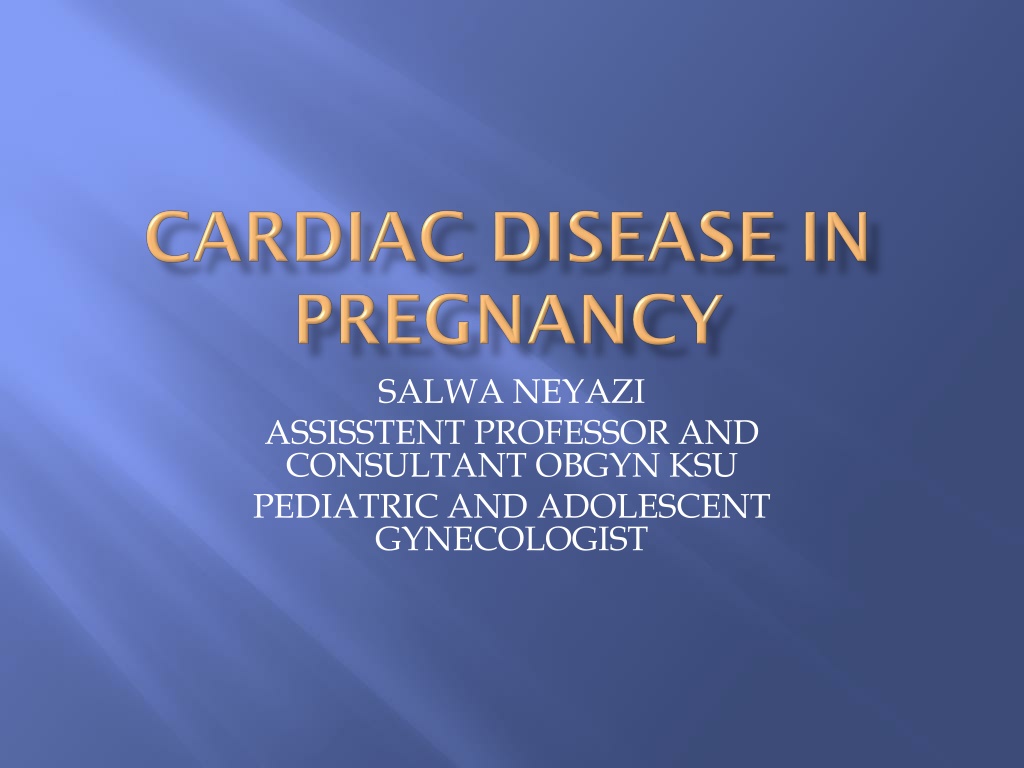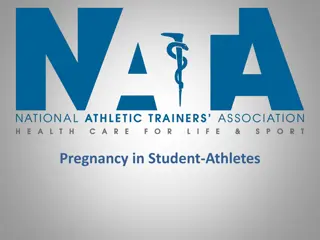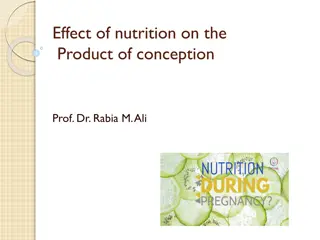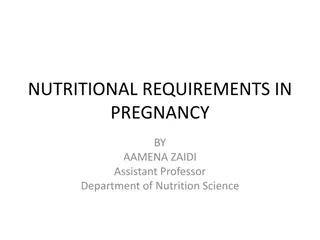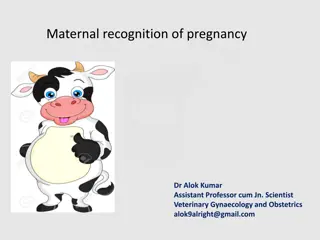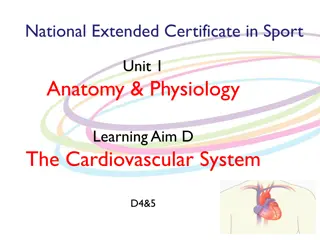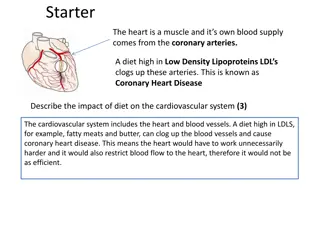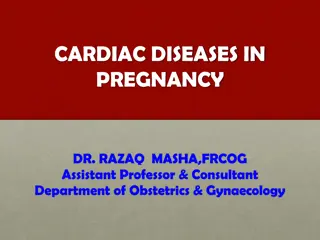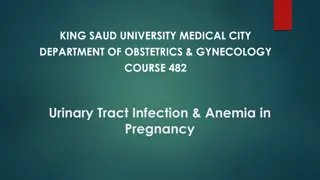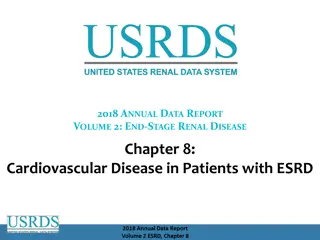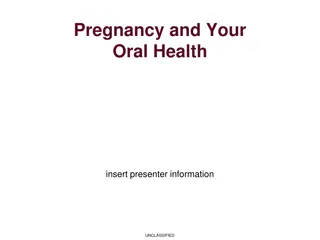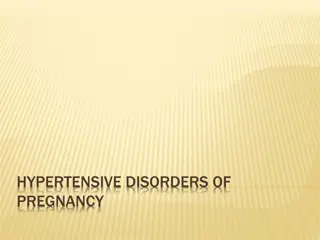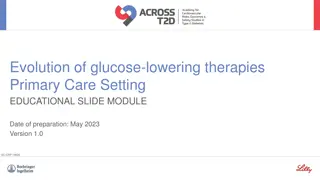Understanding Cardiovascular Changes in Pregnancy
This informative content discusses the normal physiological changes of the cardiovascular system in pregnancy, symptoms and signs of cardiovascular disease, the impact of pregnancy on cardiovascular health, and the management of cardiovascular issues during pregnancy, labor, and the postpartum period. It covers topics such as blood volume increase, cardiac output changes, blood pressure variations, and the effects of labor and delivery on the maternal heart. Additionally, it touches upon postpartum considerations like vena cava compression relief and changes due to epidural anesthesia.
Download Presentation

Please find below an Image/Link to download the presentation.
The content on the website is provided AS IS for your information and personal use only. It may not be sold, licensed, or shared on other websites without obtaining consent from the author. Download presentation by click this link. If you encounter any issues during the download, it is possible that the publisher has removed the file from their server.
E N D
Presentation Transcript
SALWA NEYAZI ASSISSTENT PROFESSOR AND CONSULTANT OBGYN KSU PEDIATRIC AND ADOLESCENT GYNECOLOGIST
To understand the normal physiological changes of CVS in pregnancy Symptoms and signs suggestive of CVS disease When to investigate for cardiac disease Types and grades of CVS disease Effect of pregnancy on CVS disease and effect of cardiac disease on pregnancy Prepregnancy counselling Management of CVS disease in pregnancy, labor and purperium
Starts around 5-8 wks of prgnancy Peak at late second trimester 20-24 wks Symptoms ad signs due to these changes include fatigue, dyspnea, decreased exercise capacity, peripheral edema, physiologic systolic murmur and 3rdheart sound
A-blood volume Increase 40-50% up to 32 wks Plasma volume increase(50%) more then RBC mass (20%) resulting in physiologic anemia B-Cardiac output Rises 30-50% (max 20 wks) by increased blood volume, reduced systemic vascular resistance and increase maternal heart rate by 10-15 BPM . Stroke volume increase in 1stand 2ndtrimester and decrease in the third trimester
C- Slight decrease in BP (diastolic reduced more than systolic) D-Labor and delivery Each uterine contraction result in displacement of 300-500 cc of blood to the general circulation ----increase stroke volume and cardiac output by about 50% BP & HR increase due to pain and anxiety blood loss during delivery compromise the hemodynamic state
E-Postpartum Relieve of vena caval compression by the gravid uterus -----increase venous return --- increase cardiac output 10-20 %---diuresis F-Changes due to epidural anesthesia Peripheral vasodilation----decrease cardiac output & BP / therefore Pt. need prehydration
There is overlap with the common symptoms of pregnancy fatigue dyspnea orthopnea palpitation edema systolic flow murmur 3rdheart sound) Symptoms that merit a cardiac evaluation in pregnancy Progressive limitation of physical activity Chest pain Syncope
History and physical exam ECG Chest radiogram Echcardiogram
NYHA Class Symptoms Cardiac disease, but no symptoms and no limitation in ordinary physical activity, e.g. shortness of breath when walking, climbing stairs etc. I Mild symptoms (mild shortness of breath and/or angina) and slight limitation during ordinary activity. II Marked limitation in activity due to symptoms, even during less-than- ordinary activity, e.g. walking short distances (20 100 m). Comfortable only at rest. III Severe limitations. Experiences symptoms even while at rest. Mostly bedbound patients. IV
A- Before conception Should be informed about the added risk of pregnancy on her self & the fetus Class III and IV ---mortality rate up to 7% and morbidity 30% -----should be cautioned against pregnancy Factors that predict the woman chance of having adverse cardiac or neonatal complication: 1-a prior cardiac event 2-cyanosis or poor functional class 3-Valvular or outflow tract obstruction 4- myocardial dysfunction ( LVEF<40% cardiomyopathy)
Cardiac assessment as early as possible ( by cardiologist) Termination of pregnancy if there is a serious threat to maternal health Close follow up by both obstetrician and cardiologist Observe for signs and symptoms of heart failure
American Heart Association published a consensus statement that there is no need for antibiotics prophylaxis (to prevent B E in patient with cardiac lesions ) for vaginal delivery nor cesarean section as the risk of bacteremia is low 1- 5% IV antibiotics can is optional if bacterimia is suspected or for high risk patients (prosthetic cardiac valve, previous BE, complex cyanotic congenital HD, surgical pulmonary shunts or conduits, VSD, PDA ) Ampicillin 2 gm + Gentamicin 1.5 mg/kg within 30 minutes of procedure followed by Ampicillin 1 gm after 6 hours
1-Cardiomyopathy(CMP) Look for symptoms and signs f congestive heart failure(CHF) Heart failure is often refractory to treatment Serious condition with 5 year survival rate of 50% 2-Peripartum cardiomyopathy Dilated CMP occurs in late pregnancy or first 6 months post partum Incidence 1:1300-15000 Unknown cause Mortality 25-50% due to CHF, thrombo-emoblism or arrhythmia Need intensive monitoring and treatment during pregnancy and labor by cardiologist and OB
3-Septal defects ASD VSD Usually tolerate pregnancy well ASD most common congenital lesion ASD can cause atrial flutter . Rx after preg by catheter ablation Rarely uncorrected lesions lead to Lt to Rt shunt, pulmonary HPT and CHF Fetalechocardiography ----incidence of VSD 4% 4-Patent ductus arteriosus Well tolerated in pregnancy unless there is pulmonary HPT
5-Mitral regurgitation Usually well tolerated in preg except in Pt with atrial fibrillation or severe HPT Pt with severe MR should be advised surgical correction before pregnancy 6-Mitral prolapse Most common congenital defect Rarely have any implications on maternal fetal health
7-Aortic Regurgitation Generally well tolerated Severe disease should have surgical repair before pregnancy 8-Aortic stenosis Mild-mod well tolerated in preg Severe ---deteriorate in 2nd or 3rd trimester --- dyspnea, angina, syncope or CHF May require balloon valvoplasty in pregnancy Monitoring with SG-Catheter in labor No epidural Instrumental delivery to shorten the second stage Mortality 17% Any hypotension can causesudden death Postpartum blood loss ---reduce preload and volume resuscitation is necessary
9-Mitral Stenosis Moderate to severe disease often show deterioration in third trimester or labor--- increased blood volume & heart rate---pulmonary edema Atrial fibrillation ---Cardiac failure Normal vaginal delivery with swanz ganz catheter monitoring in severe /mod cases Needs good pain relief in labor to reduce maternal heart rate and increase diastole Can not tolerate the 2nd stage because of decreased preload with pushing therefore require instrumental delivery to shorten the 2nd stage Post partum autotransfusion can result in pulmonary oedema ---requires aggressive diuresis
A-Tetrology of Fallot (Rt to Lt shunt &cyanosis) Rt ventricular outflow obstruction VSD Rt Vent hypertrophy Overriding Aorta Complications Heart failure 40% Spontaneous abortions & preterm labor IUGR Shunt worsen in labor & postpartum Invasive cardiac monitoring in labor
B-Eisenmengers Syndrome Communication between pulmonary & systemic circulation (eg large VSD) Lt to Rt shunt-----pulmonary HPT ----Rt to LT shunt Termination of pregnancy advisable MMR ---50% PP death one wk after delivery up to 4-6 wks FMR---50% IUGR 30% Preterm delivery 85% During preg ---Rx limitation of physical activity, oxygen, pulmonary vasodilators Risk of death is greatest during labor & early postpartum Requires central hemodynamic monitoring in labor & instrumental delivery
C-Coarctation of the Aorta Surgical correction in pregnancy only if dissection occurs They have fixed cardiac output therefore maintain demand of preg by increasing heart rate D-Marfan s Syndrome Congenital weakness of the connective tissue Aortic root dilatation / mitral valve prolapse/ Aneurisms Sever cases---complications in preg / aortic dissection or rupture Aortic valve replacement before pregnancy Avoid HPT /B blockers from 2ndtrimester to avoid tachycardia Delivery contraversial CS Vs SVD
E-Idiopathic Hyprtrophic Subaortic stenosis Lt Vent outflow tract obstruction Worsen in the late 2nd/3rdtrimester Lt ventricular failure Supraventricular arrhythmias F-Ebstein s anomaly Malformation of the Tricuspid valve Surgical correction before preg G-Congenital atrioventricular block Pacemaker/ tolerate preg well
11-Arrhythmias Premature atria/ventricular complexes no adverse outcome in preg Atrial fibrillation/flutter ---rare in preg Rx digoxin & B blockers Serious arrhytmias should be treated before preg 12-Ischemic heart disease Uncommon in preg 67% occure in 3rdtrimester If MI occurs before 24 wks ---termination of preg If delivery occurs within 2 wks of MI ---mortality 50%
A.Anticoagulants 1.Enoxaparin (Lovenox) 2.Dalteparin (Fragmin) 3.Danaparoid (Orgaran) 4.Heparin C.Antiarrhythmic 1.Encainide 2.Sotalol (Betapace) - first trimester only D.Diuretics 1.Torsemide (Demadex) 2.Amiloride B.Antihypertensives 1.Methyldopa (Aldomet) 2.Acebutolol (first trimester only) 3.Pindolol (first trimester only) E.AntiHyperlipidemic 1.Cholestyramine 2.Colestipol
A.Antiplatelet Medications 1.Clopidogrel (Plavix) 2.Dipyridamole (Persantine) 3.Ticlopidine B.Antiarrhythmic 1.Atropine 2.Digoxin 3.Disopyramide (Norpace) 4.Lidocaine 5.Procainamide 6.Quinidine 7.Amiodarone a.Neonatal Hypothyroidism b.Intrauterine Growth Retardation c.Cardiac disturbance C.Diuretics 1.Acetazolamide (Diamox) 2.Furosemide (Lasix) 3.Mannitol D.Lipid lowering medications 1.Niacin 2.Gemfibrozil (Lopid)
E.Antihypertensive 1.Hydralazine 2.Diazoxide 3.Clonidine 4.Nitroprusside (Nipride) 5.Prazosin 6.Reserpine 7.All Calcium Channel Blockers a.Nifedipine XL (is a drug of choice for severe Hypertension in Pregnancy) b.Avoid other Calcium Channel Blockers in pregnancy 8.Most Beta Blockers (first trimester only) a.Labetolol (drug of choice for severe Hypertension in Pregnancy) b.Metoprolol c.Nadolol d.Propranolol e.Timolol f.Esmolol (Class C in all trimesters)
A.Anticoagulants 1.Coumadin (Warfarin) 2.Dicumarol B.Antihypertensive 1.ACE Inhibitors 2.Angiotensin II Antagonists 3.Most Beta Blockers (second and third trimester) a.Associated with Intrauterine Growth Retardation b.Metoprolol c.Nadolol d.Propranolol e.Timolol f.Acebutolol (second and third trimester) g.Pindolol (second and third trimester) h.Atenolol C.Diuretics 1.Ethacrynic Acid 2.Triamterene (Class B per manufacturer) 3.Bumetanide (Bumex) 4.Hydrochlorothiazide 5.Spironolactone
